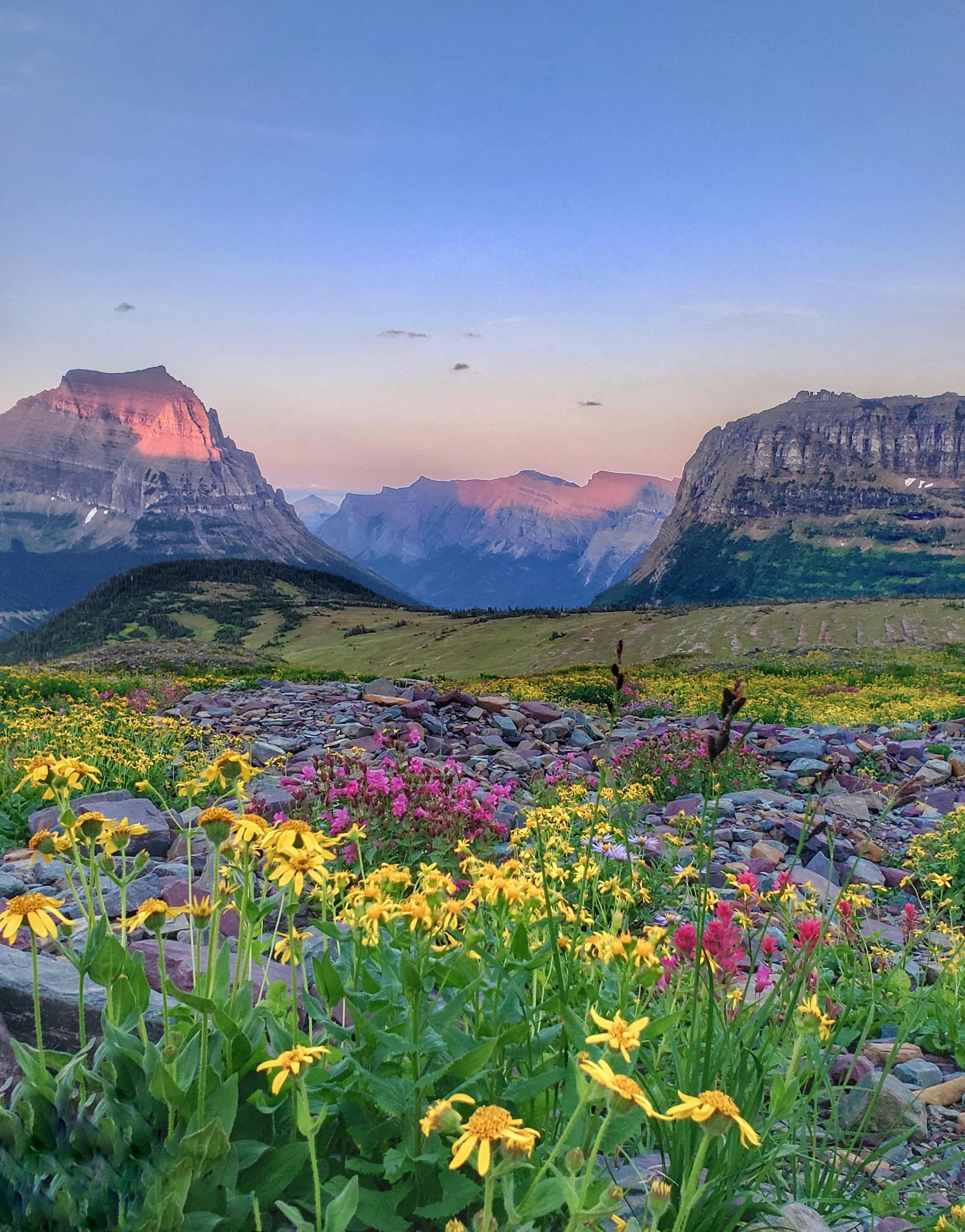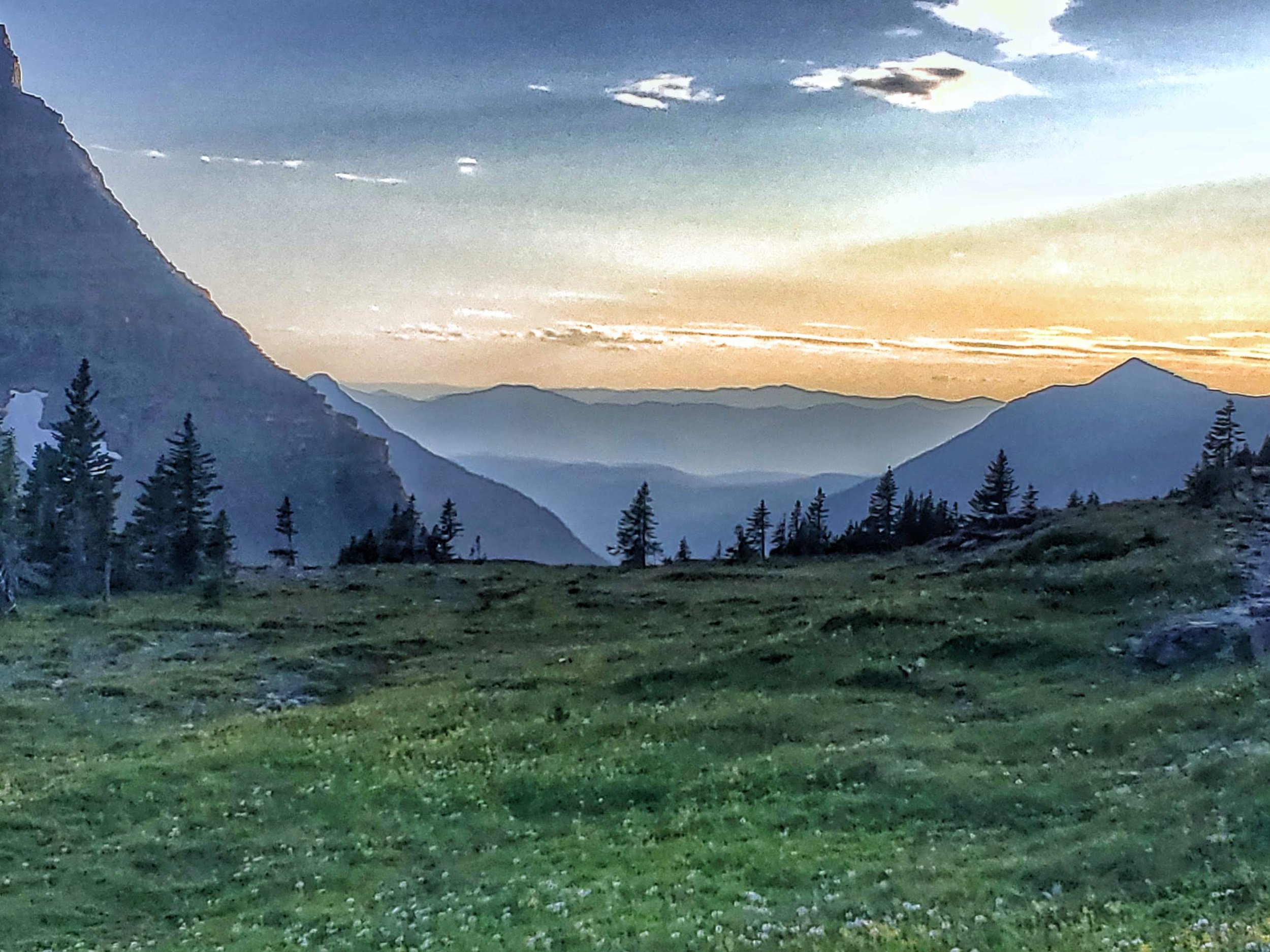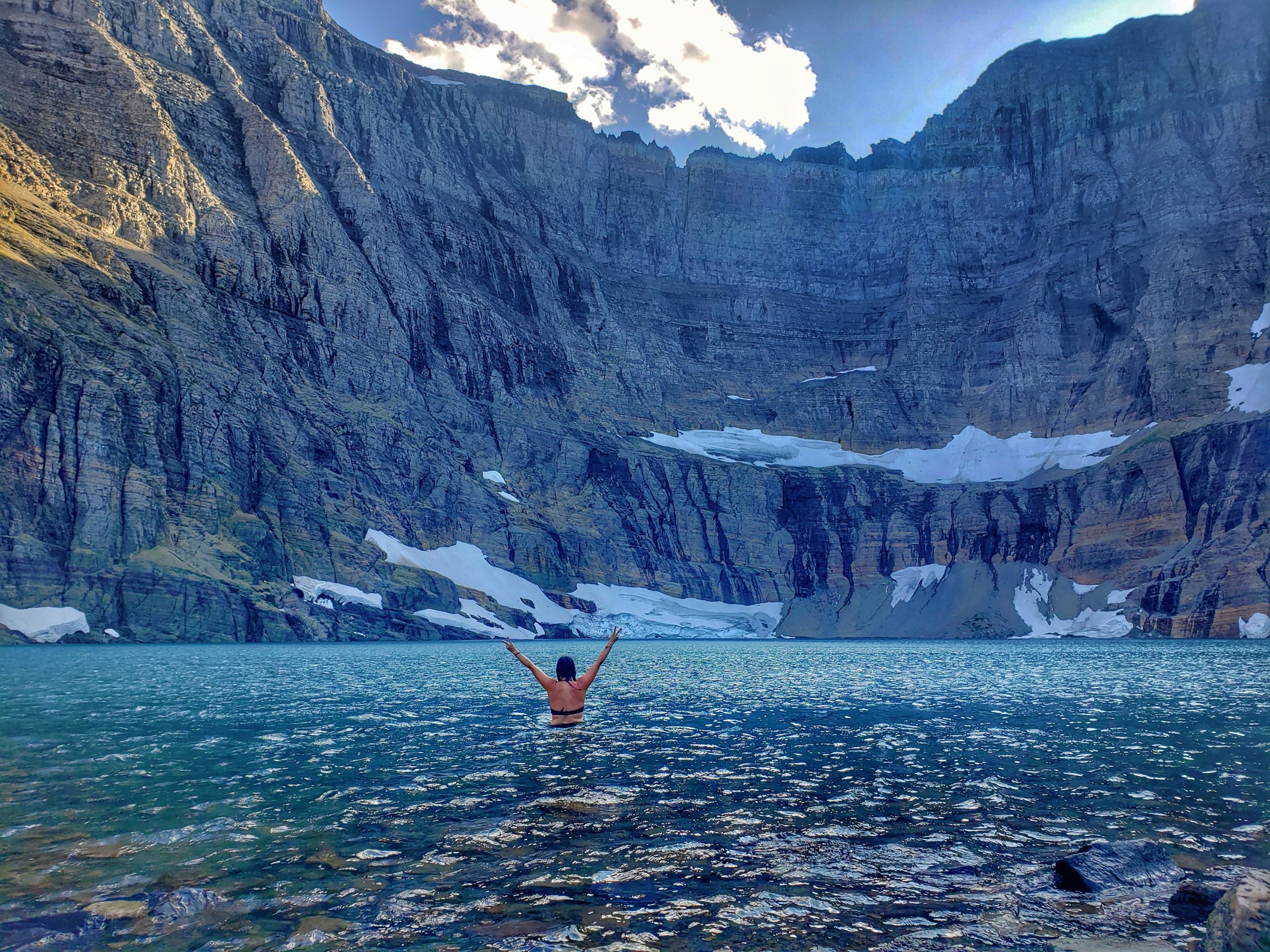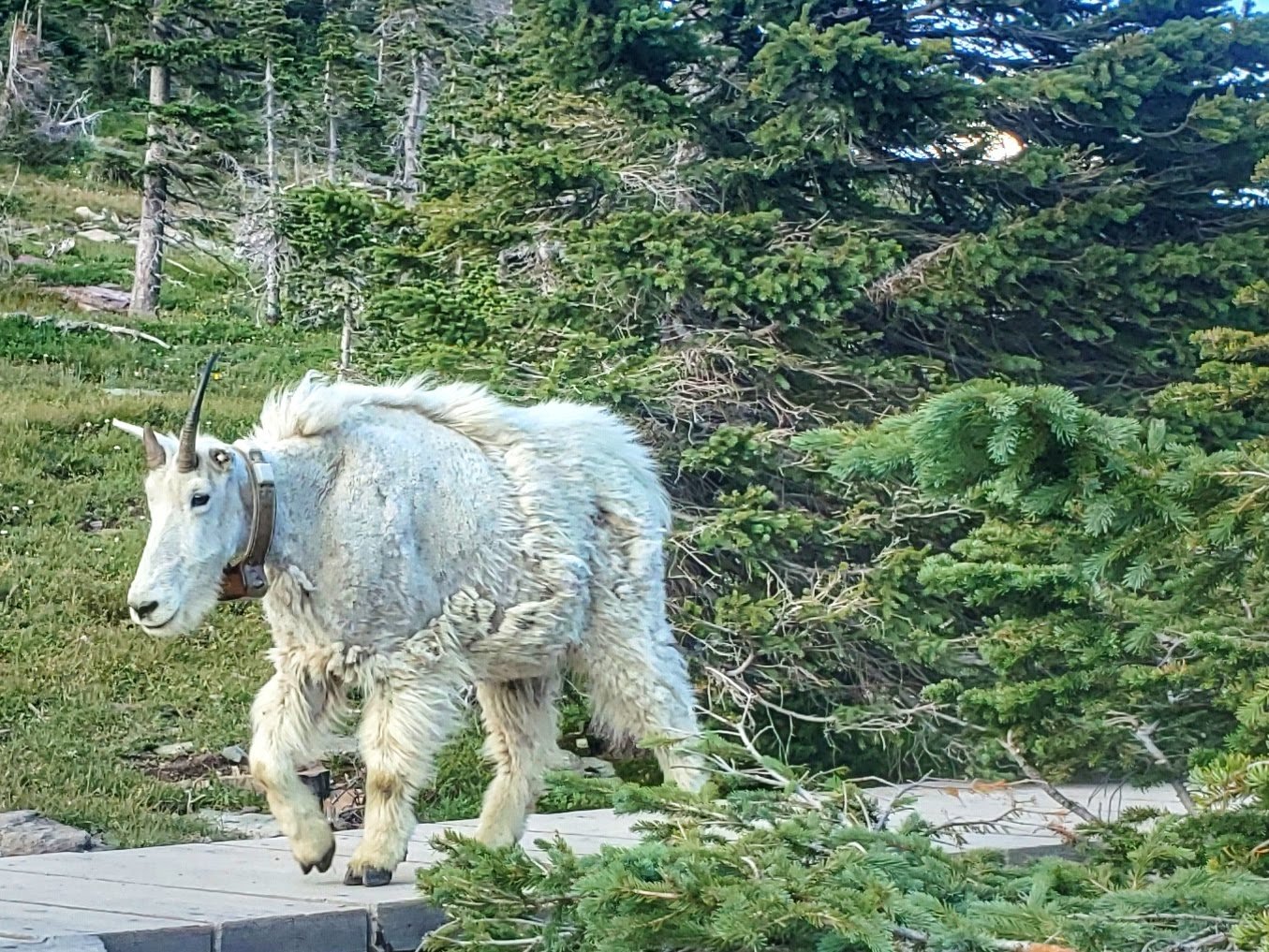For over a century, people have sought out America’s 10th designated National Park, for its 1 million acres of preserved rugged peaks, dense forests, 130 clear turquoise lakes, 1,000 different species of plants, glacial-carved peaks and valleys and rushing waterfalls. However, before it became a renowned public attraction, it was home to the members of the Blackfeet Nation, who call it “the backbone of the world”. The Blackfeet have cared for and lived off this region for 10,000 years. The Blackfeet Nation currently occupies a reservation adjacent to Glacier NP, which is 1.5 million acres large. However, its original territory used to cover most of Montana’s northern half. For all the beauty of the park, we owe thanks to the Blackfeet, the original stewards of the land.
Bison once openly roamed this land. However, as bison were killed off, starvation became a reality for the Blackfeet and they were eventually persuaded to lease their land to the US Government, which opened access to the Great American Railroad. George Grinnell, a conservationist and editor first came to the area of the park in 1885 and almost yearly thereafter. His articles in “Forest and Stream” created considerable interest in the area, and today, credit goes to Grinnell for swinging public opinion in favor of the legislation which made this area into a national park in 1910.
As Americans’ love grew for the automobile, so did their desire to explore Glacier National Park. Roads through the park were in demand, which eventually led to creation of the Going-to-the-Sun Road. A picturesque, mind-blowingly beautiful road which stretches 50 miles between West Glacier to St. Mary, climbing up and over the Continental Divide and peaking at Logan Pass. The first road planned called for 15 switchbacks cutting up the side of the mountain. Luckily, the final road left a much smaller footprint on nature. With only 1 switchback and a design cut into the rock cliffs, the Going to the Sun (GTS) Road is one of the best mountain roads in America and can be seen as a blueprint for merging man with nature.
Basics to Planning a National Park Visit
Each of the 59 national parks in the U.S. offers up its own magical experience. Whether you plan to try and visit several or only have time for Glacier, there are some tips that can help ensure your visit to these national treasures is as memorable as the scenery they offer.
Park Pass
First off, a park pass is required at all Glacier entrances. If you plan to visit other National parks in the same year, an annual America the Beautiful National Parks Pass will save you money and time and your funds will help protect national treasures for generations to come.
Pets
Only a handful of national parks allow your favorite furry companion on trails and in campgrounds. To ensure you and Fido don’t get turned away, make note that Glacier only allows pets in developed areas but pets are not permitted on trails, along lake shores, in the backcountry or in any building and they must be on a leash no longer than 6 feet at all times
Plan and Book Ahead
Some of the more popular national parks draw massive crowds - the competition for Glacier camping spots is fierce and sites often get booked as soon as they become available (six months in advance). While Glacier is not in the top 10 largest national parks, it has fewer entrances and takes more time to transverse. Showing up with a few plans will help maximize the available time you have.
Befriend the Rangers
Rangers know the parks inside and out. They can provide tips to help you stay safe and also to maximize the enjoyment of this experience. Make friends upon arrival by asking about the top spots to hit, what to stay away from, shortcuts to get to places, and things to look out for along the way.
Read on to learn more about
Best Times to Visit
How to Get There
Where to Stay
What to Do
What to Pack
The Best Time to Visit
Time of Year
The best weather months are July and August - however, June and early September are great to avoid crowds and minimize the chance for forest fires.
Note: if you are interested in driving the GTS Road all the way to Logan Pass, the alpine portion is only open part of the year. Be sure you look up any seasonal restrictions or need for reservations.
Time of Day
Another tip to avoid the crowds is to take advantage of the early morning magic. Waking before dawn, you’ll find traffic in the park almost non-existent. Create a lifelong memory as you watch the sunrise over Glacier NP.
If early mornings aren’t your thing, crowds can still be avoided by soaking in the beauty of the park later in the day. Whether it is a picnic next to one of the many lakes or a pre-sunset hike, make the time to sit in silence for a few minutes and let the magic of nature sink in.
Note: If you choose to explore the park close to dawn and dusk, be sure to keep an extra eye out for the wildlife that also prefer the cooler temps and fewer visitors. Exploring Glacier NP is like walking into a painting. However, hyper vigilance should be practiced as this territory is shared with fearsome predators.
How to Get There
By Plane
The main airport is Glacier International. Otherwise, you could fly into a nearby city for cheaper flights and an opportunity to maximize your roadtrip sightseeing, such as including a visit to Yellowstone.
Rent a Car
Given the popularity of this national treasure, you are encouraged to rent a car in advance. Rental companies are available from the airport or in Kalispell or Whitefish. However, both Outdoorsy and Turo are great options for getting around and help put money back into the local community.
Hint, rent a smaller car to more easily navigate tight turns on Going to Sun Road
Shuttles
Whether you need a shuttle for necessity or desire it for ease, Glacier NP offers shuttles to help you navigate the park. Be sure to check schedules and stops well in advance, in order to assess if a reservation is needed or if you will be able to access your desired location.
Tours
Along with a plethora of local knowledge and insight, guided tours can often include meals, permits and access passes, cutting way down on your planning, albeit limiting some flexibility of schedule.
Whitefish Outfitters offers guided sightseeing tours via a guided drive or renting various bicycles to take in the sights of Glacier National Park & the Flathead Valley.
Founded in 1983, Glacier Guides and Montana Raft provides ecologically sensitive backcountry guiding which offers rafting, hiking, fishing, biking, equipment rentals, and lodging.
A guided tour can ease any discomfort you may have exploring the park on your own. The majority of the parks will have outfits that know the park inside and out and can help craft just the experience for which you’ve dreamed up along with taking some of the stress off of you when it comes to planning.
Where to Stay
Lodging, in the Park
In 1932 Glacier National Park was designated as part of the Waterton-Glacier International Peace Park, a strong symbol of shared stewardship between Canada and the U.S. Just as the wildlife and magnificent landscape are part of the heritage of Glacier National Park, so are the historic lodges, which offer an abundance of rooms and stand ready to welcome the park’s visitors and help create memorable and meaningful experiences to last a lifetime. Find out more here.
RV and Tent Camping, in the Park
With more than a dozen options, you may think you are safe to just show up and camp. However, be sure to check months in advance for spaces in the park itself, or you may need to consider a campground nearby. For detailed information about each campground, such as campground fees and amenities, location, number of sites, RV length accommodated, and historic fill times, please visit the Campground Status page.
Outside of the park
Depending on how close you want to stay to the park, dispersed camping and hotels are both readily available. Flathead Lake opens a gateway to some of the best that NW Montana has to offer. The Flathead Valley is a short 45 min drive from the West park entrance and offers the largest freshwater lake west of the Mississippi, quaint fun towns, and tons of nature hikes in its hundreds of thousands of acres of national forests
What to Do
Drive Going-to-the-Sun Road
Reaching the top of the alpine section feels like you are on top of the world. However, if you are there when the full road is not open, we still suggest driving what you can, as it all presents epic views.
Reaching the top of the alpine section feels like you are on top of the world
Water Activities
With over 130 clear turquoise lakes, there is no shortage of water centric activities - we suggest renting a canoe or kayak - rentals are available at all 4 campgrounds - just note that mountain summers often mean windy afternoons, and on these lakes, that means plenty of chop. If you want to minimize paddling in a strong headwind, early morning and late afternoon will be your sweet spot.
Plenty of opportunity abounds for both spin and fly fishing, although your catch can range from mediocre (at best) to excellent. No license is needed but we suggest a little research in advance to familiarize yourself on rules and limits.
Wildlife Viewing
The slopes and valleys of Many Glacier are great for Wildlife Viewing
Insider Tip:
Go right before dusk and bring a picnic for after, to enjoy along Lake Sherburne, as you watch the sun set
Hiking
Several of my favorite hikes are Hidden Lake Overlook, from Logan Pass; St. Mary and Virginia Falls and Many Glacier. If you are up for a longer trek, I suggest the Highline Trail or Grinnell Glacier.
Hidden Lake Overlook
While you are likely to encounter plentiful visitors and an overflowing parking lot, Hidden Lake Overlook is popular for a reason - it is a trail accessible to most abilities with absolutely outstanding views and ample opportunity for seeing wildlife - visitors regularly encounter Marmots, Mountain Goats, Rams and will occasionally see wolves and bears as well. During the wildflower season, the meadow will be bursting with colors.
St. Mary and Virginia Falls
Don’t let portions of burnt forest dissuade you; the colors of the lake and river add icing to the cake on this beautiful, multiple waterfall hike. As you ease further into the hike, you will get to enjoy moments of solitude coupled with several unnamed waterfalls and continuously babbling creeks. As you pause for photo ops, you'll also likely notice the incredibly beautiful aqua-green color of the pools just below the falls. If you don’t mind adding some miles to avoid heavier traffic, include Baring Falls in your plan and park at Sun Point.
Highline Trail
For those looking to add a few more miles in exchange for lofty views, this is one of the most incredible day hikes in Glacier. Making it extra unique, the Highline Trail begins on the Continental Divide, serving up dreamworthy views right from the start. If you aren’t sure about tackling the full length, less ambitious hikers can still snag great views in the first three miles, which start off fairly level.
Grinnell Glacier
You will drive a little further off the beaten path and log more miles. However, the hike to Grinnell Glacier is one of Glacier National Park's most beautiful hikes. This hike is all-inclusive - offering scenic valley views, waterfalls, stunning alpine scenery, emerald green lakes, wildflowers and of course, a glacier. Visit at the right time and you can witness icebergs floating across the lake or possibly share your trek with moose, mountain goats and bears.
Note: before picking out a destination on a map and blindly heading out, make sure you know how much vertical you will be gaining, how long the hike is, and the type of terrain the trail passes through. Backwards plan how long you think the hike will take so you are not caught without enough water, snacks or after dark. AllTrails is a great resource for these details.
Stargazing
Glacier is home to some of the darkest skies in the world. In 2017, the International Dark Sky Association named Glacier Park and its Canadian counterpart, Waterton Lakes National Park, the world’s first transboundary international dark sky park.
Glacier Adjacent Activities
During the middle of day, which is the busiest time in Glacier NP, we suggest exploring the surrounding area. Flathead Lake, the largest freshwater lake west of the Mississippi is an easy drive and presents absolutely gorgeous scenery. You can also look at rafting Flathead River, biking the Gateway to Glacier Trail or exploring a number of local breweries or restaurants - a fun challenge is to see who makes the best huckleberry pie or ice cream!
Pay homage to the original stewards of this land by spending an afternoon reading more about Blackfoot history and purchasing authentic Indian arts and crafts.
Off-the-beaten-path
If you want to access less trafficked areas of Glacier, Polebridge Entrance is a remote entrance into Glacier which is primarily used by the locals and hardy visitors. There are miles and miles of backcountry trails and lakes, making this a backpacking paradise. If you visit in the winter, when the snow flies, there is plenty of fun to be had with cross country skiing.
What to Pack
Having the right gear is integral to your enjoyment of your trip. Glacier NP straddles the Continental Divide, which can mean extreme weather when the opposing Pacific and Arctic airs meet. Check the forecast before you leave and remember it can get cold in the park in May and even into July. Be sure to pack warmer clothes, which can be layered, along with rain gear, in case the weather changes on you.
Packing Suggestions
Bring a daybag. A smaller pack can be filled with things you’ll use during the day - this should include sunscreen, a hat, water bottle or bladder, snacks, and sunglasses.
Pack a picnic. When you venture into the park, bring a picnic with you. You can either opt to do a full meal picnic, or just some snacks.
Prepare for varying weather and wildlife. Along with your warm layers and rain gear, you’ll want a sturdy pair of shoes, an easy to reach harness for bear spray and a swimsuit.
Opt for a backpack versus a suitcase in order to be more mobile and to provide an option which you can use for a variety of things.
If outdoor adventure is new to you or you want to save room in your pack, there are options in both Kalispell and WhiteFish to rent gear.
*Note: This is not an exhaustive packing list but hopefully it can get your wheels turning as you plan your epic trip. Also, if bear spray is new to you, make sure to watch a few YouTube videos on safe and effective usage and be aware that you cannot fly with it.
Overall
Glacier National Park was one of America’s first national parks, and you can’t beat it for all its adventure, breathtaking views, and amazing hikes. However, it is also an expansive park. Without stopping, it takes at least 2 hours to drive the full 50 miles of Going-to-the-Sun Road. If you can, we recommend three days at the minimum in Glacier , in order to explore a variety of what Glacier has to offer.



















